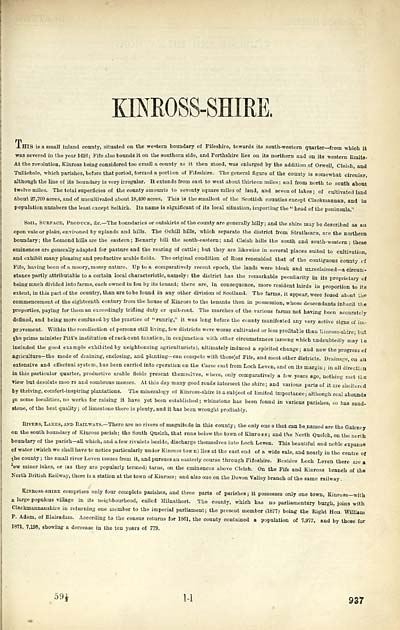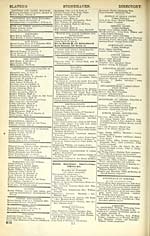Scotland > 1868, 1878 - Slater's (late Pigot & Co.'s) Royal national commercial directory and topography of Scotland > 1878 > Part 1
(1015)
Download files
Complete book:
Individual page:
Thumbnail gallery: Grid view | List view

KIMOSS-SHIRE.
J. HIS Is a email inland connty, situated on the weitern boundary of Fifeshire, towards its sonth-western quarter— from which it
was severed in the year 1426; Fife also bounds it on the southern side, and Perthshire lies on its northern and on its western limits-
At the revolution, Kinross being considered too small a connty as it then stood, was enlarged by the addition of Orwell Cleish and
Tnlliebole, which parishes, before that period, formed a portion of Fifeshire. The general figure of the county is somewhat circular
although the line of its boundary is very irregular. It extends from east to west about thirteen miles ; and from north to south about
twelve miles. The total superficies of the county amounts to seventy square miles of land, and seven of lakes ; of cultivated land
about 27,700 acres, and of imcultivated about 18,400 acres. This is the smallest of the Scottish counties except Clackmannan and ia
population numbers the least except Selkirk. Its name is significant of its local situation, importing the " head of the peninsula."
Soil, Subface, PRODncE, &c.— The boundaries or outskirts of the county are generally hilly ; and the shiro may ba described as an
open vale or plain, environed by uplands and hills. The Ochill hills, which separate the district from Strathearn, are the northern
boundary; the Lomond hills are the eastern; Benarty hill the south-eastern; and Cleish hills the south and south-western- these
eminences are generally adapted for pasture and the rearing of cattle ; but they are likewise in several places suited to cultivation
and exhibit many pleasing and productive arable fields. The original condition of Ross resembled that of the contiguous county ct
Fife, having been of a moory, mossy nature. Up to a comparatively recent epoch, the lands were bleak and unreclaimed— a oircum-
stance partly attributable to a certain local characteristic, namely : the district has the remarkable peculiarity in its pronrietarv £
being much divided into farms, each owned in fen by its tenant; there are, in consequence, more resident lairds in proportion to its
extent, in this part of the country, than are tobe found in any other division of Scotland. The farms, it appear, were feued about the
commencement of the eighteenth century fi-om the house of Kinross to tho tenants then in possession, whose descendants inherit tlie
properties, paying for them an exceedingly trifling duty or quit-rent. The marches of tho various farms not having been accurately
defined, and being more confused by the practice of " runrig," it was long before the county manifested any very active signs of im-
provement. Within the recollection of persons stUl living, few districts were worse cultivated or less profitable than lunross-shii-e- but
the prime minister Pitt's institution of rack-rent taxation, in conjunction with other circumstances (among which undoubtedly may I e
included the good example exhibited by neighbouring agriculturists), ultimately induced a spirited change ; and now the progress of
agriculture-the mode of draining, enclosing, and planting— can compete with those;of Fife, and most other districts. Drainage on an
extensive and effectual system, has been carried into operation on the Carse east from Loch Leven, and on its margin; in aU direction
in this particular quarter, productive arable fields present themselves, where, only comparatively a few years ago, nothing met tLo
view but desolate moo rs and sombrous mosses. At this day many good roads Intersect the shire; and various parts of it are shcltertd
by thi-Iving, oomfort-inspii-ing plantations. The mineralogy of Kinross-shire is a subject of limited impoitance ; although coal abounds
in some localities, no works for raising it have yet been established; whinstone has been found in various parishes, so has sand-
stone, of the best quality ; of limestone there is plenty, and it has been wrought profitably.
Rivers, Lakes, and RAiLwAvs.-There are no rivers of magnitude in this county; the only one s that can be named are the Gairney
on the south boundary of Kinross parish; the South Quelch, that runs below the town of Kinross; and the North Quelch, on the north
boundary of the parish-aU which, and a few rivulets beside, discharge themselves into Loch Leven. This beautiful and noble expanse
of water (which we shall have to notice particularly under Kinross tow n ) lies at the east end of a wide vale, and nearly in the centre of
the county ; the smaU river Leven issues from it, and pursues an easterly course through Fifeshire. Besides Loch Leven there are a
'ew minor lakes, or (as they are popularly termed) tarns, on the eminences above Cleish. On the Fife and Kinross branch of the
North British RaUway, there is a station at the town of Kinross; and also oue on the Devon VaUey branch of the same railway.
KiNEoss-SHiEE comprises only four complete parishes, and three parts of parishes ; It possesses only one town, Kinross-with
a large populous village in its neighbourhood, called Milnathort. The county, which has no parhamentary burgh, joins with
Clackmanaaushire in returning one member to the imperial parliament; tho present member (1877) being the Eight Hon. William
P. Adam, of Blairadam. According to the census returns for 1861, the county contained a population of 7,977, and by those for
1871, 7,198, showing a decrease in the ten years of 779.
m 1-1 937
J. HIS Is a email inland connty, situated on the weitern boundary of Fifeshire, towards its sonth-western quarter— from which it
was severed in the year 1426; Fife also bounds it on the southern side, and Perthshire lies on its northern and on its western limits-
At the revolution, Kinross being considered too small a connty as it then stood, was enlarged by the addition of Orwell Cleish and
Tnlliebole, which parishes, before that period, formed a portion of Fifeshire. The general figure of the county is somewhat circular
although the line of its boundary is very irregular. It extends from east to west about thirteen miles ; and from north to south about
twelve miles. The total superficies of the county amounts to seventy square miles of land, and seven of lakes ; of cultivated land
about 27,700 acres, and of imcultivated about 18,400 acres. This is the smallest of the Scottish counties except Clackmannan and ia
population numbers the least except Selkirk. Its name is significant of its local situation, importing the " head of the peninsula."
Soil, Subface, PRODncE, &c.— The boundaries or outskirts of the county are generally hilly ; and the shiro may ba described as an
open vale or plain, environed by uplands and hills. The Ochill hills, which separate the district from Strathearn, are the northern
boundary; the Lomond hills are the eastern; Benarty hill the south-eastern; and Cleish hills the south and south-western- these
eminences are generally adapted for pasture and the rearing of cattle ; but they are likewise in several places suited to cultivation
and exhibit many pleasing and productive arable fields. The original condition of Ross resembled that of the contiguous county ct
Fife, having been of a moory, mossy nature. Up to a comparatively recent epoch, the lands were bleak and unreclaimed— a oircum-
stance partly attributable to a certain local characteristic, namely : the district has the remarkable peculiarity in its pronrietarv £
being much divided into farms, each owned in fen by its tenant; there are, in consequence, more resident lairds in proportion to its
extent, in this part of the country, than are tobe found in any other division of Scotland. The farms, it appear, were feued about the
commencement of the eighteenth century fi-om the house of Kinross to tho tenants then in possession, whose descendants inherit tlie
properties, paying for them an exceedingly trifling duty or quit-rent. The marches of tho various farms not having been accurately
defined, and being more confused by the practice of " runrig," it was long before the county manifested any very active signs of im-
provement. Within the recollection of persons stUl living, few districts were worse cultivated or less profitable than lunross-shii-e- but
the prime minister Pitt's institution of rack-rent taxation, in conjunction with other circumstances (among which undoubtedly may I e
included the good example exhibited by neighbouring agriculturists), ultimately induced a spirited change ; and now the progress of
agriculture-the mode of draining, enclosing, and planting— can compete with those;of Fife, and most other districts. Drainage on an
extensive and effectual system, has been carried into operation on the Carse east from Loch Leven, and on its margin; in aU direction
in this particular quarter, productive arable fields present themselves, where, only comparatively a few years ago, nothing met tLo
view but desolate moo rs and sombrous mosses. At this day many good roads Intersect the shire; and various parts of it are shcltertd
by thi-Iving, oomfort-inspii-ing plantations. The mineralogy of Kinross-shire is a subject of limited impoitance ; although coal abounds
in some localities, no works for raising it have yet been established; whinstone has been found in various parishes, so has sand-
stone, of the best quality ; of limestone there is plenty, and it has been wrought profitably.
Rivers, Lakes, and RAiLwAvs.-There are no rivers of magnitude in this county; the only one s that can be named are the Gairney
on the south boundary of Kinross parish; the South Quelch, that runs below the town of Kinross; and the North Quelch, on the north
boundary of the parish-aU which, and a few rivulets beside, discharge themselves into Loch Leven. This beautiful and noble expanse
of water (which we shall have to notice particularly under Kinross tow n ) lies at the east end of a wide vale, and nearly in the centre of
the county ; the smaU river Leven issues from it, and pursues an easterly course through Fifeshire. Besides Loch Leven there are a
'ew minor lakes, or (as they are popularly termed) tarns, on the eminences above Cleish. On the Fife and Kinross branch of the
North British RaUway, there is a station at the town of Kinross; and also oue on the Devon VaUey branch of the same railway.
KiNEoss-SHiEE comprises only four complete parishes, and three parts of parishes ; It possesses only one town, Kinross-with
a large populous village in its neighbourhood, called Milnathort. The county, which has no parhamentary burgh, joins with
Clackmanaaushire in returning one member to the imperial parliament; tho present member (1877) being the Eight Hon. William
P. Adam, of Blairadam. According to the census returns for 1861, the county contained a population of 7,977, and by those for
1871, 7,198, showing a decrease in the ten years of 779.
m 1-1 937
Set display mode to: Large image | Transcription
Images and transcriptions on this page, including medium image downloads, may be used under the Creative Commons Attribution 4.0 International Licence unless otherwise stated. ![]()
| Scottish Post Office Directories > Scotland > Slater's (late Pigot & Co.'s) Royal national commercial directory and topography of Scotland > 1878 > Part 1 > (1015) |
|---|
| Permanent URL | https://digital.nls.uk/90200539 |
|---|
| Attribution and copyright: |
|
|---|---|
| Description | Directories of the whole, or large parts of, Scotland. |
|---|
| Description | Around 700 Scottish directories published annually by the Post Office or private publishers between 1773 and 1911. Most of Scotland covered, with a focus on Edinburgh, Glasgow, Dundee and Aberdeen. Most volumes include a general directory (A-Z by surname), street directory (A-Z by street) and trade directory (A-Z by trade). |
|---|


